Assessment of scattering rate and mechanical properties of blends of polypropylene / polyamide containing modified Nano clay and compatibilizer
Naser Gharehbash*,1 and Alireza Shakeri2
1Candidate of Academy sciences andFaculty of science, University of Golestan, Gorgan, Iran
2University College of Science, University of Tehran, Tehran, Iran
*Corresponding Author, E-mail: d.gha.5na@gmail.com
DOI : http://dx.doi.org/10.13005/ojc/31.Special-Issue1.31
Article Received on :
Article Accepted on :
Article Published : 05 Sep 2015
In this research, dispersion and mechanical properties of polypropylene and polyamide polymers blended with Nano clay (Cloisite 15A) and compatibilizer maleic anhydride (PP-g-MA) was studied. Two kinds of Nano composites-profile (PP / PA / Nano clay 50/50/5 W / W / phr) and PP / PA / PP-g-MA / clay (50/50/5/5, W / W / phr / phr) were compared. SEM images clearly showed that improved dispersion and compatibility of the polymer and Nano clay increased. Mechanical test results showed that the addition of PP-g-MA compatibilizer for PA / PP and PP/ PA improved adhesion to each other and increase the tensile strength, flexural strength and impact strength of the PA/PP.
KEYWORDS:Nano composites; Polypropylene (PP); Polyamide (PA); Nano clay; Blending; compatibilizer
Download this article as:| Copy the following to cite this article: Gharehbash N, Shakeri A. Assessment of scattering rate and mechanical properties of blends of polypropylene / polyamide containing modified Nano clay and compatibilizer. Orient J Chem 2015;31(Special Issue1). |
| Copy the following to cite this URL: Gharehbash N, Shakeri A. Assessment of scattering rate and mechanical properties of blends of polypropylene / polyamide containing modified Nano clay and compatibilizer. Orient J Chem 2015;31(Special Issue1). Available from: http://www.orientjchem.org/?p=10603 |
Introduction
One of the earliest applications of Nano filler production Nano technology was to improve mechanical properties of composites. Interest in production of composite materials with reinforcements at Nano level has grown quickly in recent years [1, 2]. Recently there has been a growing interest for the development of polymer/clay Nano composites due to their dramatic improved properties compared to the conventional filled polymers in a very low fraction of filler addition [3,4].the intrinsic incompatibility of hydrophilic clay layers with hydrophobic polymer chains prevents the dispersion of Nano clay layers within polymer matrix and causes to the weak interfacial interactions. Incompatibility and weak interfacial interactions hinders the exfoliation and preparation of dispersed stable Nano composite with improved properties. Modification of clay layers with hydrophobic agents is necessary in order to render the clay layers more compatible with polymer chains [5,6].
In general, the structures of polymer/clay Nano composites are classified according to the level of intercalation and exfoliation of polymer chains into the clay galleries. Various parameters including clay nature, organic modifier, and polymer matrix and preparation method are affective on the intercalation and exfoliation level [7]. The first and important goal in the application of fillers to the polymer is improvement in the mechanical properties and therefore fillers are commonly called as reinforcement agents [8-11]. It should be noticed in higher loadings of compatibilzers, they may cause to the some degree of plasticization due to their lower molecular weight, which negatively affect on the modulus of Nano composite [12,13].
Blending of polymers is an attractive method to obtain new polymeric materials. However, compatibilization is generally required to control the morphology and to improve the interfacial properties of immiscible polymer pairs [14-15]. Polypropylene(PP) useful polymers Which has the advantages of low cost, easy to molding, and general properties are suitable. The incorporation of PA, PP can of advantages the relatively good mechanical properties PA and PP should be easy to molding. Because of its high polarity and hydrogen bonding properties of polyamides Strong, normally with most polymers are not incorporation of. Therefore, theTo fixes this limitation it is necessary to used the compatibilzers .With maleic anhydride polypropylene bonded to(PP-g-MAH) Can be used as a compatibilizer for the incorporation of PA and PP. By adding PP-g-MAH, the adhesions between the phases of the PA and PP Increased by mechanical properties improves[16-22]. tructure of this research is as follows:
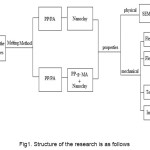 |
Figure 1: Structure of the research is as follows Click here to View figure |
Methods and Devices
The aim of this study is to investigate the effect of the addition of Nano clays in polymer. PA/PP/Nano clay and PA/PP/PP-g-MA/Nano clay (50/50/5,w/w/phr, and, 50/50/5/5, w/w/phr/phr, respectively)Nano composites are prepared in a co-rotating twin screw extruder at a screw speed of 180 rpm, a throughput of 3 kg/h and a set temperature of 210 ºC. The samples were analyzed using scanning electron microscopy. The results showed a fine morphology for both blends. Polypropylene, PP, (Moplen V30S – Arak petrochemical) with Melt flow index 19gr/10min, Polyamide, PA, Akulon F223-Da company DSM with Melt flow index 13gr/10min ,commercial Nano clay produced by America’s southern-clay company Cloisite 15A (C15A) consisting of MMT modified organically with quaternary alkyl ammonium salts and PP grafted with maleic anhydride, PP-g-MA (kimia javid esfehan) were used Table1. Table 2 shows the composition of the blends and Nano composites prepared for this research. Before compounding, Materials were dried under vacuum at 80 ºC during 20-24 hours, and then tumble mixed with PP or PP-g-MA.
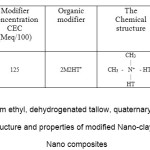 |
Table 1: chemical structure and properties of modified Nano-clay (Cloisite15A) used in Nano composites |
Table 2: Shown are blends of Nano composites
|
Blends |
Polypropylene (PP)W% |
Polyamide (PA) W% |
PP-g-MA (MA) (phr) |
Cloisite 15A |
|
PP/PA |
50 |
50 |
0 |
0 |
|
PP/PA/PP-g-MA |
50 |
50 |
5 |
0 |
|
PP/PA/Nanoclay |
50 |
50 |
0 |
5 |
|
PP/PA/PP-g-MA / Nanoclay |
50 |
50 |
5 |
5 |
Device Analysis (mechanical testing)
Tensile test according to ASTM D638 standard speed of 50 mm / min bending test standard ASTM D790, 30 mm distance between the support and the speed of 3 mm / min was performed
Results and Discussion
To view (to see) the effects of adding PP-g-MA on the uniformity blend and dispersion PP /PA and also modified clay in the polymer, SEM Images of the impact fracture sections were prepared (fig 2).
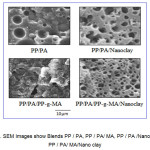 |
Figure 2: SEM Images show Blends PP / PA, PP / PA/ MA, PP / PA /Nano clay, PP / PA/ MA/Nano clay Click here to View figure |
In Fig 3-A are Shown, PP and PA without compatibilizer reluctant to mix with each other and form two distinct phases, including phase to form spherical particles with a diameter of more than 50 microns in both these phases fields were observed
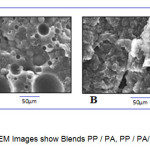 |
Figure 3: SEM Images show Blends PP / PA, PP / PA/ PP-g-MA Click here to View figure |
Mechanical test results also show that the blend PA6/PP Has favorable mechanical properties According to the fig 2, addition of 5 phr compatibilizer, PP-g-MATo improve the adhesion between the two phases, homogeneous structure established. The results of the experiments showed that the compatibility strength, tensile strength and impact strength, there was a good correlation. The fig 4(a-d) shows the Blends of mechanical properties of polypropylene / polyamide 5% compatibilizer and 5% in the use of the modified Nano clay shows.
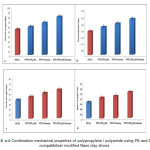 |
Figure 4 a,d: Combination mechanical properties of polypropylene / polyamide using 5% and 5% compatibilizer modified Nano clay shows Click here to View figure |
Results of mechanical testing revealed that the use of 5% compatibilizer and 5% Nano clay modified blends polypropylene / polyamide, flexural strength of 33%, flexural modulus of 45%, tensile strength 40% impact strength 41% Increases. Surface modification of Nano particles using melt mixing conditions imposed for compatibility and mixed and samples of the extruder and injection device, an important role in determining the uniformity of the samples, the distribution of particles and polymer particles and adhesion qualities have played.
Conclusion
SEM images of polymer clay improve the dispersion and compatibility is clearly indicated. Mechanical test results showed that the modified Nano clay improve the compatibility and adhesion to each other and improve tensile strength, flexural strength and impact strength are significantly increases.
References
- A.L. Roes, E. Marsili, E. Nieuwlaar, and M.K. Patal , Environmental and Cost Assessment of a Polypropylene Nanocomposite, Journal of Polymers and the Environment., 2002, 15(3): 217-226.
- I. Kvien,Characterization of Biopolymer Based Nanocomposite, PhD Thesis, Norwegian University of Science and Technology, 2007.
- E.T. Thostenson , C. Li , and T.W. Chou, Nanocomposites in context, Compos. Sci. Technol., 2005, 65 : 491-516.\
- S. Pavlidou, and C.D. Papaspyrides, A review on polymer-layered silicate nanocompopsites., Prog. Polym. Sci., 2008; 32 :1119-1198.
- M.B. Ahmad , W.H. Hoidy, N.A.B. Ibrahim, and E.A.J. Al-Mulla , Modification of montmorillonite by new surfactants., J. Eng. Appl. Sci., 2009, 4(3) :184-188.
- G. Chigwada, D. Wang, D.D. Jiang, and C.A. Wilkie, Styrenic nanocomposites prepared using a novel biphenyl-containing modified clay, Polym. Degrad. Stab. 2006, 91:755-762.
- S.S. Ray , A new possibility for microstructural investigation of clay-based polymer nanocomposite by focused ion beam tomography., Polymer, 2010, 51: 3966-3970.
- L. Jiang , Y.C. Lam, K.C. Tam, T.H. Chua , G.W. Sim , and L.S. Ang , Strengthening acrylonitrile-butadiene-styrene (ABS) with nano-sized and micron-sized calcium carbonate., Polymer, 2005, 46: 243-252.
- G. Gorrasi, M. Tortora, V. Vittoria, E. Pollet, B. Lepoittevin, and M. Alexandre, Vapor barrier properties of polycaprolactone montmorillonite nanocomposites: effect of clay dispersion. Polymer, 2003, 44 :2271–2279.
- M. Tortora, G. Gorrasi, V. Vittoria, G. Galli, S. Ritrovati, and E. Chiellini , Structural characterization and transport properties of organically modified montmorillonite / polyurethane nanocomposites., Polymer, 2002, 43 :6147–6157.
- M.A. Osman, J.E.P. Rupp, and U.W. Suter , Effect of non-ionic surfactants on the exfoliation and properties of polyethylene – layered silicate nanocomposites. Polymer, 2005, 46: 8202-8209.
- V. Mittal, Mechanical and gas permeation properties of compatibilized polypropylene – layered silicate nanocomposites., J. Appl. Polym. Sci., 2008, 107: 1350-1361.
- R. Scaffaro, M.C. Mistretta , and F.P. La Mantia , “Compatibilized polyamide 6/polyethylene blendclay nanocomposites: Effect of the degradation and stabilization of the clay modifier” ,Polymer Degradation and Stability, 2008, 93(7): 1267-1274.
- W. Schaefer, and R.S. Justice, “How nano are nanocomposites?”, Macromolecules, 2007; 40(24):8501- 8517.
- Y. Yoo, and D.R. Paul, “Effect of organoclay structure on morphology and properties of nanocomposites based on an amorphous polyamide”, Polymer, 2008, 49(17) :3795-3804.
- Z.A. Mohd Ishak, Kusmono, W.S. Chow, T. Takeichi, and H. Rochmadi, Effect of Organoclay Modification on the Mechanical, Morphology, and Thermal Propertiese of Injection Molded Polyamide6/Polypropylene/ Montmorillonite Nanocomposites, Proceedings of the Polymer Processing Society 24th Annual Meeting, Salerno (Italy), 2008, 15-19.
- X. Zhou, P. Zhang, X. Jiang, and G. Rao, Influence of Maleic Anhydride Grafted Polypropylene on the Miscibility of Polypropylene/ Polyamide-6 Blends Using ATR-FTIR Mapping, Vibrational Spectroscopy, 2009; 49: 17-21.
- T.D. Lam, T.V. Hoang, D.T. Quang, and J.S. Kim, Effect of Nanosized and Surface-Modified Precipitated Calcium Carbonate on Properties of CaCO3/Polypropylene Nanocomposites, Mater. Sci. Eng., 2009, 501 : 87-93.
- P. Agrawal, S.I. Oliveira, E.M. Araujo, and T.J.A. Melo, Effect of Different Polypropylenes and Compatibilizers on the Rheological, Mechanical and Morphological Properties of Nylon 6/PP Blends, Mater. Sci., 2007, 42: 5007-5012.
- M.Y.A. Fuad, H. Hanim, R. Zarina, Mohd Z.A. Ishak, and A. Hassan, Polypropylene/Calcium Carbonate Nanocomposites – Effects of Processing Techniques and Maleated Polypropylene Compatibiliser, eXPRESS Polym. Lett., 2010, 4 :611-620.
- B.Suresha, Ravi B.N. Kumar, M. Venkataramareddy, and T. Jayaraju, Role of Micro/Nano Fillers on Mechanical aTribological Properties of Polyamide66/Polypropylene Composites, Mater. Design, 2010, 31: 1993-2000.
- Z.A. Kusmono, Mohd Ishak, W.S. Chow, T. Takeichi, and Rochmadi, Enhancement of Properties of PA6/PP Nanocomposites via Organic Modification and Compatibilization, eXPRESS Polym. Lett., 2008; 2 : 655-664.

This work is licensed under a Creative Commons Attribution 4.0 International License.









